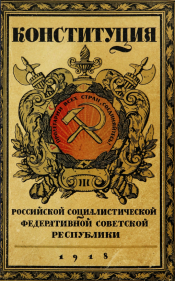
The Presidential Library collections - marking the 100th anniversary of the first Soviet Constitution
July 10, 2018 marks the 100th anniversary of the adoption of the first Constitution of the young Soviet state. The portal and the collections of the Presidential Library present a large array of electronic documents that reveal a great deal of work on the drafting of the first and subsequent constitutions of post-revolutionary Russia. They are included in a large collection "Constitution - Basic Law" - it contains, in particular, the texts of the first constitution of the RSFSR of 1918, as well as the three constitutions of the USSR (1924, 1936 and 1977) and their editions.
"The First Soviet Constitution: (Constitution of the RSFSR of 1918)", published in 1938, is a collection of documents edited by A. Y. Vyshinsky. It, in addition to the text of the Constitution, involves amendments to its draft, made by Lenin, as well as the first Soviet decrees, articles and speeches of V. I. Lenin, J. V. Stalin and V. M. Molotov, the nationalization of the merchant marine, the abolition of state loans, the separation of the church from the state and the school from the church, and other materials on the basis of which specialists have done a tremendous job of creating the world's first Constitution of the state of workers and peasants.
This Constitution emerged in the fire of the Civil War, which predetermined its features, resulting from the prevailing socio-political situation. According to A. Vyshinsky in the preface, "At that time the Soviet Republic was subjected to the combined pressure of external and internal counterrevolution, a ring of civil war fronts was drawn around the Soviet state".
The situation did not seem to have the lawmaking, but the need to outline the main parameters of the legal space made it work.
"We know", - Lenin says in the collection, "that this Soviet constitution ... is not invented by any commission, is not composed by lawyers, is not written off from other constitutions. In the world there were no such constitutions as ours. It records the experience of the struggle and organization of the proletarian masses against the exploiters both inside the country and throughout the world. We have a supply of experience in the struggle ... We are starting to work, attracting new employees who are needed to carry out the Soviet constitution".
In the prevailing severe geopolitical conditions, the Soviet state took the first steps towards its approval, reflecting in the decrees and laws the will of the victorious workers' and peasants' masses. Each of these decrees of the Soviet government was the largest historic milestone in the way of creation of the first Soviet Constitution. Among the main gains and first steps towards socialism were the liquidation of private ownership of the tools and means of production, the mastery of the proletarian state by commanding heights in the national economy. The main gains also included "the consolidation of the most democratic rights and freedoms among the working people".
The content of the decrees issued during this period received its generalization in the Leninist-Stalinist Declaration of the Rights of the Working and Exploited People. On January 31 (18), 1918, it was unanimously approved by the Third All-Russian Congress of Soviets as a document of the greatest constitutional significance. The declaration confirmed the abolition of private ownership of land, the law on workers 'control in order to ensure the workers' power over the exploiters and as the first step towards the transition of factories, factories, mines, railways, etc. in the property of the worker-peasant state.
Chairman of VTsIK Y. M. Sverdlov said at a meeting of the All-Russian Central Executive Committee of the fourth convention (his words are also quoted in the collection) in his report on the need to attract broader sections of the working people than it was before to rule the country. "It is necessary to build Soviet power in this way", - said T. Sverdlov, "so that it would not only give the opportunity to work, but would force much broader circles of the working people to directly govern the country".
All the instructions of the VTsIK chairman Sverdlov were put in the basis of the work of the Constitutional Commission of the All-Russian Central Executive Committee, formed on April 1, 1918, and ensured the development of the basic law of the Soviet Republic. The leading role in the commission belonged to Stalin. Two days before the first meeting of the Constitutional Commission in Izvestia № 64, a conversation with J. V. Stalin was published. In this conversation, he pointed to the main tasks facing the commission, and above all to "the need for a clear definition of the principles of the Soviet federation, formed on the basis of a voluntary union of nationalities".
After elaborate editing in a special commission of the Central Committee of the Communist Party of the Soviet Union (Bolsheviks) under the direct leadership of Lenin, this project, which formalized the harmonious system of the organs of Soviet power, entered the final approval of the V All-Russian Congress of Soviets, where the Constitution was by general consent adopted.

